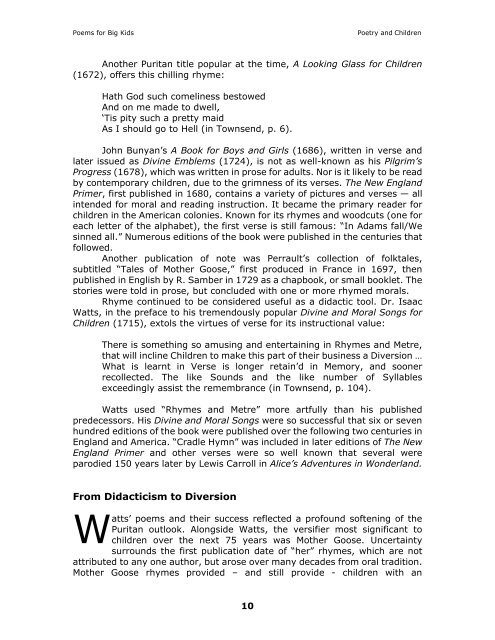Create successful ePaper yourself
Turn your PDF publications into a flip-book with our unique Google optimized e-Paper software.
<strong>Poems</strong> <strong>for</strong> <strong>Big</strong> <strong>Kids</strong> Poetry and Children<br />
Another Puritan title popular at the time, A Looking Glass <strong>for</strong> Children<br />
(1672), offers this chilling rhyme:<br />
Hath God such comeliness bestowed<br />
And on me made to dwell,<br />
‘Tis pity such a pretty maid<br />
As I should go to Hell (in Townsend, p. 6).<br />
John Bunyan’s A Book <strong>for</strong> Boys and Girls (1686), written in verse and<br />
later issued as Divine Emblems (1724), is not as well-known as his Pilgrim’s<br />
Progress (1678), which was written in prose <strong>for</strong> adults. Nor is it likely to be read<br />
by contemporary children, due to the grimness of its verses. The New England<br />
Primer, first published in 1680, contains a variety of pictures and verses — all<br />
intended <strong>for</strong> moral and reading instruction. It became the primary reader <strong>for</strong><br />
children in the American colonies. Known <strong>for</strong> its rhymes and woodcuts (one <strong>for</strong><br />
each letter of the alphabet), the first verse is still famous: “In Adams fall/We<br />
sinned all.” Numerous editions of the book were published in the centuries that<br />
followed.<br />
Another publication of note was Perrault’s collection of folktales,<br />
subtitled “Tales of Mother Goose,” first produced in France in 1697, then<br />
published in English by R. Samber in 1729 as a chapbook, or small booklet. The<br />
stories were told in prose, but concluded with one or more rhymed morals.<br />
Rhyme continued to be considered useful as a didactic tool. Dr. Isaac<br />
Watts, in the preface to his tremendously popular Divine and Moral Songs <strong>for</strong><br />
Children (1715), extols the virtues of verse <strong>for</strong> its instructional value:<br />
There is something so amusing and entertaining in Rhymes and Metre,<br />
that will incline Children to make this part of their business a Diversion …<br />
What is learnt in Verse is longer retain’d in Memory, and sooner<br />
recollected. The like Sounds and the like number of Syllables<br />
exceedingly assist the remembrance (in Townsend, p. 104).<br />
Watts used “Rhymes and Metre” more artfully than his published<br />
predecessors. His Divine and Moral Songs were so successful that six or seven<br />
hundred editions of the book were published over the following two centuries in<br />
England and America. “Cradle Hymn” was included in later editions of The New<br />
England Primer and other verses were so well known that several were<br />
parodied 150 years later by Lewis Carroll in Alice’s Adventures in Wonderland.<br />
From Didacticism to Diversion<br />
Watts’ poems and their success reflected a profound softening of the<br />
Puritan outlook. Alongside Watts, the versifier most significant to<br />
children over the next 75 years was Mother Goose. Uncertainty<br />
surrounds the first publication date of “her” rhymes, which are not<br />
attributed to any one author, but arose over many decades from oral tradition.<br />
Mother Goose rhymes provided – and still provide - children with an<br />
10



